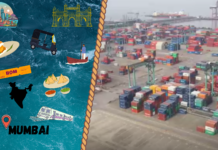
During the drone mission lasting for more than three months, the Baltic Sea coast of Lithuania and the waters of the Klaipėda port were monitored and 140 ships were examined for the quality of exhaust gases.
In particular, such possibility was provided by the European Maritime Safety Agency (EMSA), and the mission itself was led by national institutions, including the Environmental Protection Department under the Ministry of the Environment, the Klaipėda State Seaport Directorate, and the Fisheries Service under the Ministry of Agriculture.
More specifically, the Klaipeda State Seaport Authority assigned the unmanned drone that performed a mission in the port city, to carry out surveillance of the waters of Klaipėda port and the movement of ships, to measure the amount of sulphur in the exhaust gases of ships and to record cases of water pollution.
“While participating in this project and having the opportunity to use modern tools, we evaluated ship emissions and the impact of loading processes on the environment. During the project, the harbour water area was directly monitored by drone. The available results of the observations made during the mission will allow us to make the most effective decisions on how to prevent possible violations, should they occur,” commented Algis Latakas, director general of the Klaipėda State Seaport Directorate.
Furthermore, the unmanned aircraft flew five days a week in the port of Klaipėda and in the Baltic Sea looking for possible violations of environmental protection. Flying at the harbour gates, the drone studied the exhaust gases of every ship entering the harbour. The drone’s sensor was able to determine the percentage of sulphur in the ship’s fuel.
According to environmentalists, this modern drone measures the amount of sulphur in the exhaust gas and allows the determination of whether the amount of sulphur in the fuel does not exceed the set norms.
The available functions make environmental enforcement more effective and purposeful, prevent violations faster, and the increase of inspection work performance is also noticeable.
The footage captured by the drone cameras was recorded and broadcasted live to the inspectors involved in the project.
In addition, during the mission, the drone provided valuable data to Fisheries Service inspectors on Baltic Sea fishing control. Drone raids were carried out on the coasts of Juodkrantė and Melnragė, at night, early morning and during the day.





